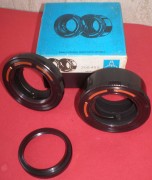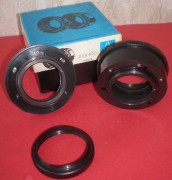seany65
Well-known
I hope no-one minds if i start a Praktica PLC3/SLR thread. I was just going to ask for some info about my PLC3, then realised that there may be owners of other Praktica models who may appreciate a single thread about them.
Anyway, I've just bought a PLC3 and would like to ask a couple of questions:
1) I've tried an AA battery in it and the meter works, but the needle is rather slower, and seems to need more adjustment of the aperture to move the needle from the "+" or "-" to the "0", than I remember on my previous two PLC3's, (which I had when Mercury batteries were still legal), so I'd like to know if this 'sluggishness' is probably just down to the lower Voltage?
2) The first three times I fired the shutter at "1 second" it seemed to struggle to close, taking the shutter time to maybe 3 or 4 seconds. It seems alright now, but I was wondering if this is a "thing" on PLC3's or other Prakticas, or if it's just "one of those things"?
3) Why would the self-timer try it's best to resist having the lever moved upwards and why would it spring back instantly while firing the shutter at the same time, even before I'd pressed the little button?
Any help would be much appreciated.
I should have asked these questions on the forum several days ago, and I apologise to you, pschauss, for not waiting for an answer to the PM I sent, but as I've no idea when you'll next be on the forum and I need to check things out soon, I thought it best to ask here as well.
Anyway, I've just bought a PLC3 and would like to ask a couple of questions:
1) I've tried an AA battery in it and the meter works, but the needle is rather slower, and seems to need more adjustment of the aperture to move the needle from the "+" or "-" to the "0", than I remember on my previous two PLC3's, (which I had when Mercury batteries were still legal), so I'd like to know if this 'sluggishness' is probably just down to the lower Voltage?
2) The first three times I fired the shutter at "1 second" it seemed to struggle to close, taking the shutter time to maybe 3 or 4 seconds. It seems alright now, but I was wondering if this is a "thing" on PLC3's or other Prakticas, or if it's just "one of those things"?
3) Why would the self-timer try it's best to resist having the lever moved upwards and why would it spring back instantly while firing the shutter at the same time, even before I'd pressed the little button?
Any help would be much appreciated.
I should have asked these questions on the forum several days ago, and I apologise to you, pschauss, for not waiting for an answer to the PM I sent, but as I've no idea when you'll next be on the forum and I need to check things out soon, I thought it best to ask here as well.
johnf04
Well-known
According to this thread on another forum, the PCL3 should work fine with a 1.5v alkaline cell. It's designed to use a 4.5v alkaline cell.
https://www.photo.net/discuss/threads/a-praktica-revisited.513515/
Your problem with the 1 second speed sounds like a sticky slow speed escapement. On these cameras, it's under the top cover, on the wind lever side.
https://www.photo.net/discuss/threads/a-praktica-revisited.513515/
Your problem with the 1 second speed sounds like a sticky slow speed escapement. On these cameras, it's under the top cover, on the wind lever side.
tunalegs
Pretended Artist
Because the self-timer is a clockwork mechanism. When you push it up you're winding the mechanism up. If it is not delaying the shutter release, then the escapement is gummed up, or broken from somebody forcing it.3) Why would the self-timer try it's best to resist having the lever moved upwards and why would it spring back instantly while firing the shutter at the same time, even before I'd pressed the little button?
seany65
Well-known
Thanks for the replies.
@johnf04: That's what I've read, though I also get the impression some plc3's don't! I just wondered if the lower voltage was making the needle move more slowly than I remembered it moving on my previous plc3s, which had 4.5v batteries.
The 1 second speed seems alright now, I just wondered if it was a known thing for most plc3s or was just mine.
@tunalegs: I understand that there would be some resistance, but this one is almost as stubborn as "Delany's Donkey" (a song by Val Doonican). Anyway, it sounds like it needs an uneconomic repair.
@johnf04: That's what I've read, though I also get the impression some plc3's don't! I just wondered if the lower voltage was making the needle move more slowly than I remembered it moving on my previous plc3s, which had 4.5v batteries.
The 1 second speed seems alright now, I just wondered if it was a known thing for most plc3s or was just mine.
@tunalegs: I understand that there would be some resistance, but this one is almost as stubborn as "Delany's Donkey" (a song by Val Doonican). Anyway, it sounds like it needs an uneconomic repair.
johnf04
Well-known
The PLC3 uses the famous Praktica L series shutter, as fitted to millions of cameras over the years. I Have 4 x L series Prakticas, and only one has sticky slow speeds - and from the looks of the camera it was stored somewhere damp. The oldest one I have is an LLC, which I bought new in 1973. The shutter works fine, but the meter died in the mid 1980s.
seany65
Well-known
Thanks johnf04.
santino
FSU gear head
I second johnf04 statement.
The shutters of the L series Prakticas are loud but reliable - 9 out of 10 (un-clad) will have exact shutter speeds.
The shutters of the L series Prakticas are loud but reliable - 9 out of 10 (un-clad) will have exact shutter speeds.
seany65
Well-known
Thanks santino.
Yup, the shutters are quite loud aren't they?
When I press the shutter button:
My little Ricoh 500GX goes "Polite Japanese click, hoping to not disturb anyone."
My Ferrania Elioflex looks round furtively, and then moves close and faintly whispers "Signore, I go 'click' now, capire?"
My PLC3 goes "DER KLUNK!"
Yup, the shutters are quite loud aren't they?
When I press the shutter button:
My little Ricoh 500GX goes "Polite Japanese click, hoping to not disturb anyone."
My Ferrania Elioflex looks round furtively, and then moves close and faintly whispers "Signore, I go 'click' now, capire?"
My PLC3 goes "DER KLUNK!"
seany65
Well-known
More puzzlement!
I've just received a Pentacon Electric 29mm and when I bunged it on my PLC3, the first 4 or so times I fired it the shutter got stuck open and the aperture blades got stuck closed to the set aperture.
Nothing happened when I altered the aperture ring nor when I switched the lens to Manual and back to Auto, it was only 'cured' by slightly unscrewing the lens- the blades opened up and the shutter closed.
It all seems alright now.
In a shop near me there's an MTL5B with 50mm lens that has a stop-down pin that can get stuck down, and with blades that can either get stuck open or closed down, but it doesn't seem to affect the shutter.
Anyone got any ideas what may be going on with my stuff?
Any help would be much appreciated.
I've just received a Pentacon Electric 29mm and when I bunged it on my PLC3, the first 4 or so times I fired it the shutter got stuck open and the aperture blades got stuck closed to the set aperture.
Nothing happened when I altered the aperture ring nor when I switched the lens to Manual and back to Auto, it was only 'cured' by slightly unscrewing the lens- the blades opened up and the shutter closed.
It all seems alright now.
In a shop near me there's an MTL5B with 50mm lens that has a stop-down pin that can get stuck down, and with blades that can either get stuck open or closed down, but it doesn't seem to affect the shutter.
Anyone got any ideas what may be going on with my stuff?
Any help would be much appreciated.
seany65
Well-known
This may seem like a daft question but I'll ask anyway.
I know PLC3's take illegal 4.5v mercury batteries and that they can also work with 1.5v AA alkaline batteries (albeit with slower/less needle movement), but can they also work with 3.6v AA-size Lithium batteries? If they can, how does they compare to alkaline cells? Do they hold a high charge for longer?
Any help would be much appreciated.
I know PLC3's take illegal 4.5v mercury batteries and that they can also work with 1.5v AA alkaline batteries (albeit with slower/less needle movement), but can they also work with 3.6v AA-size Lithium batteries? If they can, how does they compare to alkaline cells? Do they hold a high charge for longer?
Any help would be much appreciated.
johnf04
Well-known
ChrisPlatt
Thread Killer
I have a couple of later Praktica bayonet mount bodies.
They use the still commonly available PX28 6V battery.
Chris
They use the still commonly available PX28 6V battery.
Chris
oftheherd
Veteran
This may seem like a daft question but I'll ask anyway.
I know PLC3's take illegal 4.5v mercury batteries and that they can also work with 1.5v AA alkaline batteries (albeit with slower/less needle movement), but can they also work with 3.6v AA-size Lithium batteries? If they can, how does they compare to alkaline cells? Do they hold a high charge for longer?
Any help would be much appreciated.
I don't know your location, but you might want to consider https://www.google.com/search?q=equ...rome..69i57.9680j1j7&sourceid=chrome&ie=UTF-8
Mark Wood
Well-known
Occasionally, a seller on eBay lists simple adapters that let you use three LR44 batteries stacked on top of each other, instead of a PX21. (It turns up from time to time if you search "Praktica VLC".)
All you need in practice is a piece of plastic tubing, roughly the same diameter as a PX21, blanked off at one end and a self-tapping screw put through that end to act as one of the battery terminals (negative) and to support the stack of batteries inside. The positive casing of the top battery in the stack makes contact with the other terminal and hey presto, a PX21 equivalent (almost certainly of lower mAh capacity though). You just need to find the right length of screw! (I have tried this and it works perfectly but the adapter on eBay is just a more classy version of the same thing.)
I seem to recall that up until a few years ago, the Pentacon/Praktica factory did sell an adapter that allowed you to use CR123 (or CR2, I can't remember which) lithium batteries, in what I assume was a similar arrangement. Some of the manuals from the Prakticas that use a PX21, did make mention of the fact that the meters use a bridge circuit, so battery voltage wasn't a real issue.
The PX21 never was a mercury battery as far as I know, I think there's just an error on the Small Battery Company's website where they list it as one. It was always a 4.5 V alkaline battery, which originated from Mallory and it was never easy to find one in the UK. They were always somewhat adept at leaking too...
All you need in practice is a piece of plastic tubing, roughly the same diameter as a PX21, blanked off at one end and a self-tapping screw put through that end to act as one of the battery terminals (negative) and to support the stack of batteries inside. The positive casing of the top battery in the stack makes contact with the other terminal and hey presto, a PX21 equivalent (almost certainly of lower mAh capacity though). You just need to find the right length of screw! (I have tried this and it works perfectly but the adapter on eBay is just a more classy version of the same thing.)
I seem to recall that up until a few years ago, the Pentacon/Praktica factory did sell an adapter that allowed you to use CR123 (or CR2, I can't remember which) lithium batteries, in what I assume was a similar arrangement. Some of the manuals from the Prakticas that use a PX21, did make mention of the fact that the meters use a bridge circuit, so battery voltage wasn't a real issue.
The PX21 never was a mercury battery as far as I know, I think there's just an error on the Small Battery Company's website where they list it as one. It was always a 4.5 V alkaline battery, which originated from Mallory and it was never easy to find one in the UK. They were always somewhat adept at leaking too...
seany65
Well-known
Thanks for the replies.
I was under the impression that they were mercury batteries.
I know about the "small battery company" and have bought several px625 and px675 replacements from them and saw that they were out of stock of their exell a21px batteries and was looking for alternatives when I stumbled on a post on another forum mention lithium batteries so I looked for them and and saw that they can be had in the AA size, but that some are 1.5v and some were 3.6v.
I have done the "google" thing but not found quite as much info as I'd like.
I was under the impression that they were mercury batteries.
I know about the "small battery company" and have bought several px625 and px675 replacements from them and saw that they were out of stock of their exell a21px batteries and was looking for alternatives when I stumbled on a post on another forum mention lithium batteries so I looked for them and and saw that they can be had in the AA size, but that some are 1.5v and some were 3.6v.
I have done the "google" thing but not found quite as much info as I'd like.
seany65
Well-known
I've been thinking about getting some extension tubes for my pentacon electric lenses and I have recently seen a listing for this:

and I have been wondering why I would need this as the camera, lenses and the extension tubes would all have the electrical contacts for the metering already. I have noticed that in most listings the stop-down pin on the tubes doesn't always stick out far and it never seems to on both at the same time, if it does it's only on one. Do those pins only do so when attached to each other or the camera?


As always click on the thumbs for big pics. I don't think the third narrow rings are part of the original set.
I didn't take these photos and have only used them here, to ask this question.

and I have been wondering why I would need this as the camera, lenses and the extension tubes would all have the electrical contacts for the metering already. I have noticed that in most listings the stop-down pin on the tubes doesn't always stick out far and it never seems to on both at the same time, if it does it's only on one. Do those pins only do so when attached to each other or the camera?


As always click on the thumbs for big pics. I don't think the third narrow rings are part of the original set.
I didn't take these photos and have only used them here, to ask this question.
johnf04
Well-known
Seany - those rings look like an outfit that allows you to put non electric fittings between them, and still have the aperture information transferred. The stop down fittings in extension rings aren't spring loaded, so the pin may just be sitting in the fitting.
Something to remember is that exposure changes, the more extension you give the lens - you would be better sticking with stop down metering.
John.
Something to remember is that exposure changes, the more extension you give the lens - you would be better sticking with stop down metering.
John.
seany65
Well-known
Thanks john.
So I wouldn't need the "electric cable" thing if I was to just use electric tubes.
Is it not better to use open aperture metering with extension tubes, so the meter would take into account the darker image?
So I wouldn't need the "electric cable" thing if I was to just use electric tubes.
Is it not better to use open aperture metering with extension tubes, so the meter would take into account the darker image?
johnf04
Well-known
Thanks john.
So I wouldn't need the "electric cable" thing if I was to just use electric tubes.
The lower fitting in the picture has no contacts on the face towards the camera - you would need the cable.
seany65
Well-known
John, I don't think that very thin ring is actually part of the real set, it's just been added on by someone. I've just looked on "PicClik UK" and I can't see any listing for a 3-ring electric set, it seems they only come in a 2-ring set, unlike the ordinary m42 set.
Anyway, to keep things simple I would only use electric tubes.
Anyway, to keep things simple I would only use electric tubes.
Share:
-
This site uses cookies to help personalise content, tailor your experience and to keep you logged in if you register.
By continuing to use this site, you are consenting to our use of cookies.
